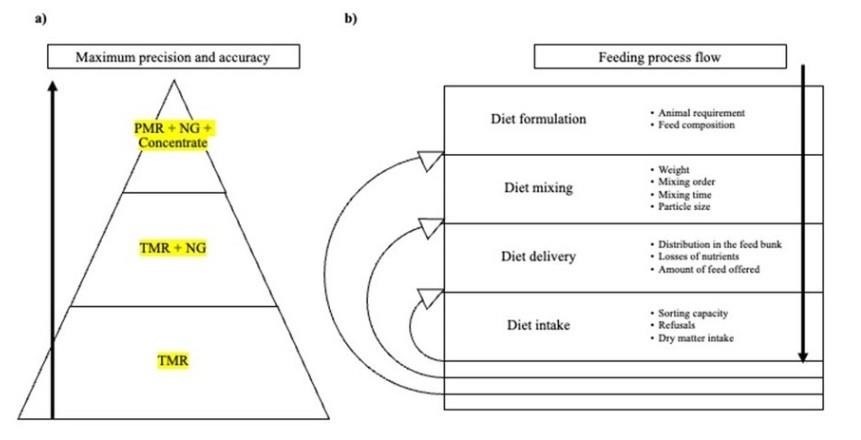By Alexander Nikolov Hristov and Leoni Martins
Feed and milk price volatility, market uncertainty, and narrow profit margins are some of the challenges dairy farmers face today. According to the USDA Economic Research Service (USDA-ERS, 2022), operating1 and total costs2 on a typical Pennsylvania dairy farm3 were $18.33/cwt and $31.22/cwt, respectively, in 2021. The gross value of selling milk, on the other hand, was $19.56/cwt in the same year. From all the possible adjustments in a dairy farm system to promote greater profits, changes in feeding management and nutrition have the greatest potential in the shortest timeframe. Enhancing cow productivity and efficiency with better nutrition can promote profitability since feed costs4 represented 75% of operating and 43% of total costs in 2021 (USDA-ERS, 2022).
Discussion about the impact of livestock production on the environment has contributed to the adoption of new technologies to improve production, economics, and environmental sustainability of dairy farms. For instance, precision dairy farming has been applied to measure productive performance, physiological parameters, and behavior of dairy cattle. Precision feeding can be described as feeding practices that aim to supply nutrients without exceeding or falling short of the requirements of the animals. In theory, precision feeding would maximize feed utilization and minimize nutrient excretion. In statistics, precision is a measure of variability. In dairy cow nutrition, precision would be related to the uniformity of nutrient intake to meet requirements of the animal. Therefore, it is expected that precision feeding should improve feed efficiency and reduce environmental emissions while reducing feeding costs.
From a practical standpoint, precision feeding can be applied throughout all steps of the feeding process (Figure 1). Frequent collection of data for milk production, milk fat and protein contents, body weight and body condition score of the cows, as well as increasing the frequency of analysis of moisture and nutrient concentrations of feed ingredients could help nutritionists better meet the nutrient needs of the cows. White and Capper (2014) demonstrated that formulating diets more frequently increased milk yield, dry matter intake, and energy balance in dairy cows. Consequently, this practice could improve returns over variable costs by $25,000/year for a dairy farm with approximately 300 cows.

Figure 1. a) Steps for application of precision feeding to achieve maximum precision and accuracy. b) Feeding process flow.
TMR = total mixed ration; NG = nutritional grouping; PMR = partial mixed ration; Concentrate = feeding concentrate individually.
Monitoring ration consistency is also important. Accurately weighing feed ingredients, following the proper mixing order and time, and adjusting the position of counter blades to prevent under or overprocessing forages are key steps to improve feeding precision. It is also necessary to make sure that the diet is adequately distributed throughout the feed bunk, and that feeding management avoids losses of nutrients through deterioration and leaching, and that the correct amount of feed is delivered. The diet consumed must be as close as possible to the diet delivered, mixed, and formulated. Additionally, evaluating the quantity and quality of feed refused, and monitoring dry matter intake are key steps to implement precision feeding and improve the feeding process.
The use of nutritional grouping of cows is a good strategy to enhance precision and accuracy of feeding in dairy farms. According to Contreras-Govea et al. (2015), 26 and 42.5% of dairy farms used a single diet to feed all lactating cows in WI and MI, respectively. Moreover, parity and stage of lactation were the first two criteria used for grouping lactating cows in both states. Using simulation to evaluate the effects of nutritional grouping management to improve diet accuracy in commercial dairy farms, Barrientos-Blanco et al. (2020) demonstrated that nutritional grouping could result in $31/cow per year greater income over feed costs (IOFC), compared with a conventional grouping system.
Feeding cows individually, based on their requirements, would be the ultimate step to achieve maximum precision and accuracy within the feeding process. This can be done by using partial mixed rations (PMR) containing forages and a certain amount of concentrate feeds offered to a group of cows, with the remaining concentrate being supplemented by feeding stations on an individual animal basis. These feeding stations operate automatically, and they can be programmed to deliver different types of concentrates based on individual requirements. An earlier study demonstrated that feeding concentrates to Jersey cows individually, based on milk production, increased income over feeding costs up to 21% (Gaynor et al., 1989). However, many questions need to be answered regarding practical application of precision feeding to the modern and high-producing dairy cow. For instance, the PMR composition, the amount of concentrate feeds offered, and the frequency of concentrate feeding in the automatic feeding station must be determined.
Different levels of precision feeding can be adopted to a different extent by all dairy systems. For example, progressively improving data collection, monitoring the feeding process flow, grouping lactating cows based on nutritional criteria, and ultimately feeding cows individually could contribute to the success of dairy farms. From all the strategies discussed in this article, measuring dry matter intake is the first critical step for implementing precision feeding on commercial dairy farms. When properly implemented, precision feeding can be a promising strategy to improve animal efficiency and profitability of dairy operations.
Source : psu.edu